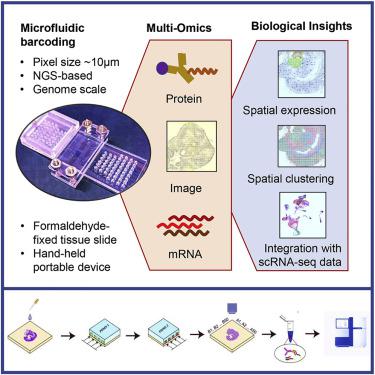Cell ( IF 45.5 ) Pub Date : 2020-11-13 , DOI: 10.1016/j.cell.2020.10.026 Yang Liu 1 , Mingyu Yang 1 , Yanxiang Deng 1 , Graham Su 1 , Archibald Enninful 2 , Cindy C Guo 2 , Toma Tebaldi 3 , Di Zhang 2 , Dongjoo Kim 2 , Zhiliang Bai 2 , Eileen Norris 2 , Alisia Pan 2 , Jiatong Li 2 , Yang Xiao 2 , Stephanie Halene 3 , Rong Fan 4

|
We present deterministic barcoding in tissue for spatial omics sequencing (DBiT-seq) for co-mapping of mRNAs and proteins in a formaldehyde-fixed tissue slide via next-generation sequencing (NGS). Parallel microfluidic channels were used to deliver DNA barcodes to the surface of a tissue slide, and crossflow of two sets of barcodes, A1-50 and B1-50, followed by ligation in situ, yielded a 2D mosaic of tissue pixels, each containing a unique full barcode AB. Application to mouse embryos revealed major tissue types in early organogenesis as well as fine features like microvasculature in a brain and pigmented epithelium in an eye field. Gene expression profiles in 10-μm pixels conformed into the clusters of single-cell transcriptomes, allowing for rapid identification of cell types and spatial distributions. DBiT-seq can be adopted by researchers with no experience in microfluidics and may find applications in a range of fields including developmental biology, cancer biology, neuroscience, and clinical pathology.
中文翻译:

通过组织中的确定性条形码进行高空间分辨率多组学测序
我们提出了用于空间组学测序 (DBiT-seq) 的组织中的确定性条形码,用于通过下一代测序 (NGS) 对甲醛固定的组织载玻片中的 mRNA 和蛋白质进行共映射。平行微流体通道用于将 DNA 条形码输送到组织载玻片的表面,并交叉流动两组条形码,A1-50 和 B1-50,然后原位连接,产生了组织像素的 2D 马赛克,每个像素都包含一个唯一的完整条形码 AB。对小鼠胚胎的应用揭示了早期器官形成中的主要组织类型以及大脑中的微血管系统和眼区中的色素上皮等精细特征。10-μm 像素中的基因表达谱符合单细胞转录组的簇,允许快速识别细胞类型和空间分布。DBiT-seq 可供没有微流体经验的研究人员采用,并可能在发育生物学、癌症生物学、神经科学和临床病理学等一系列领域中找到应用。

































 京公网安备 11010802027423号
京公网安备 11010802027423号